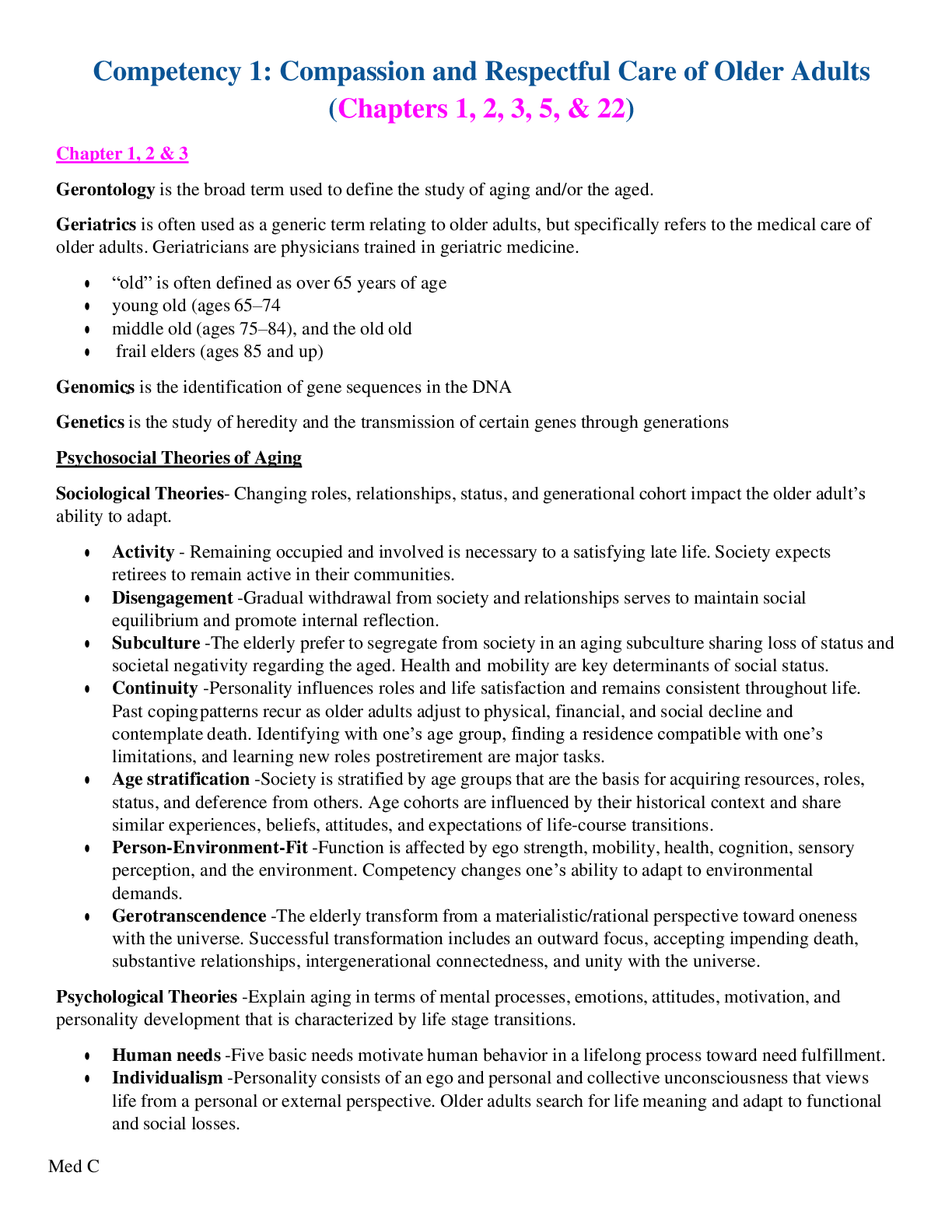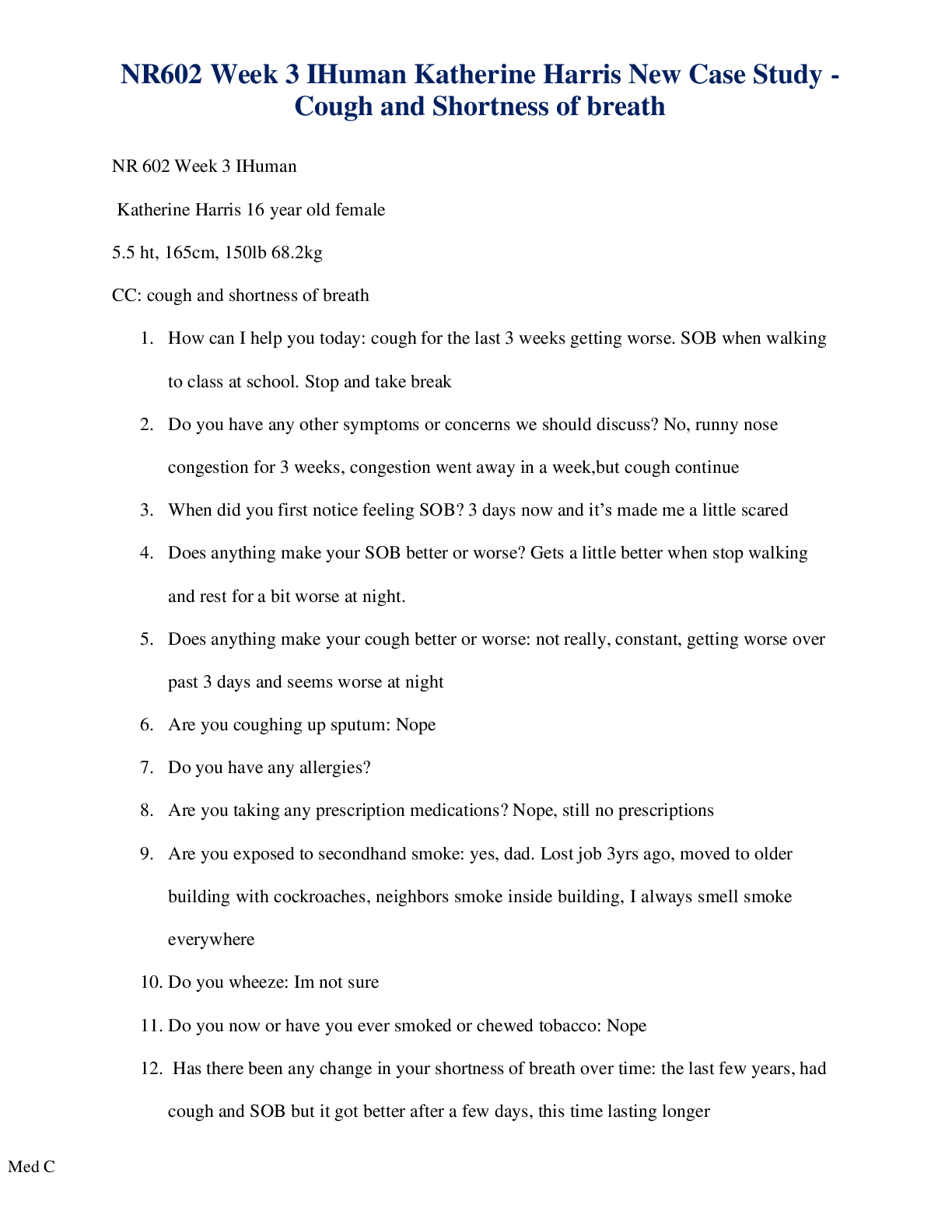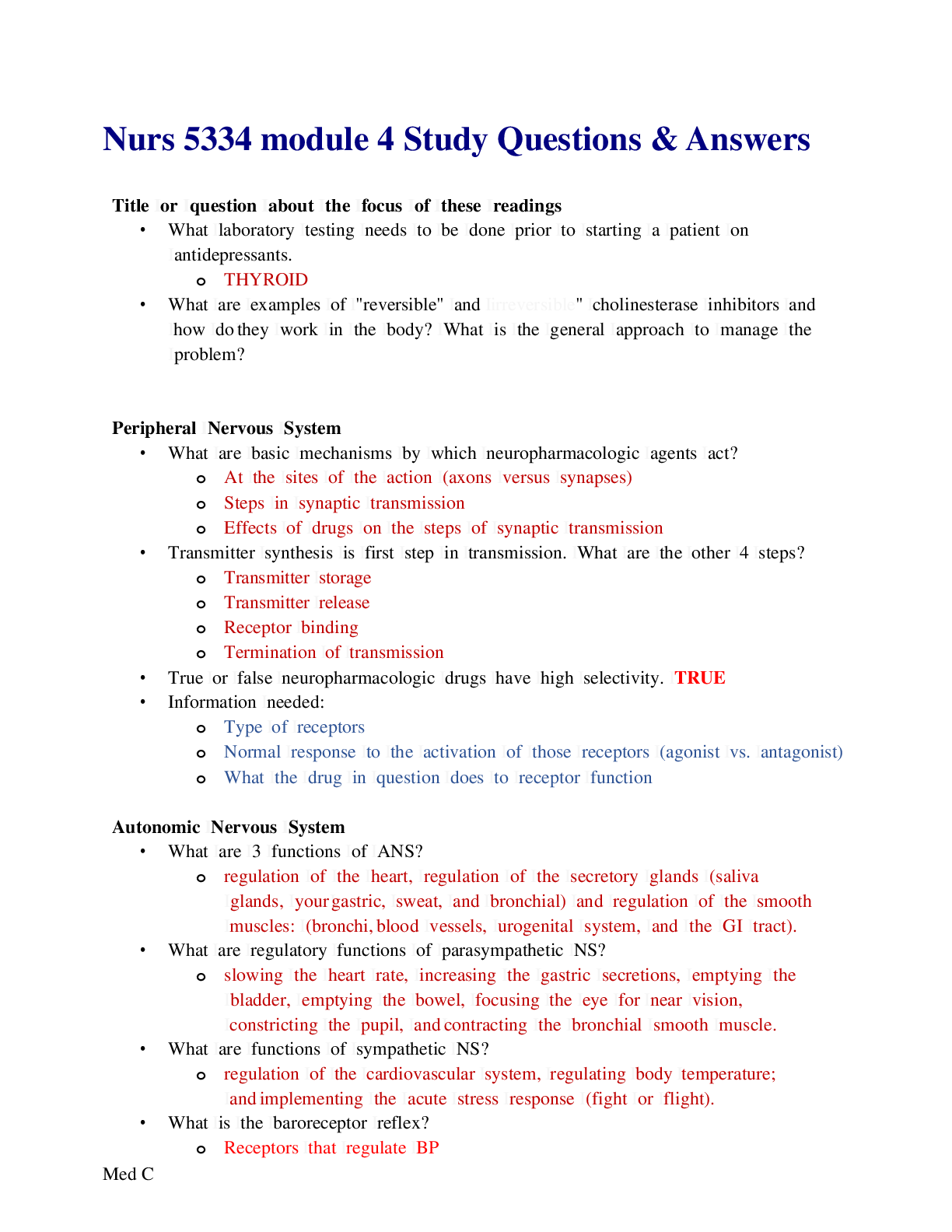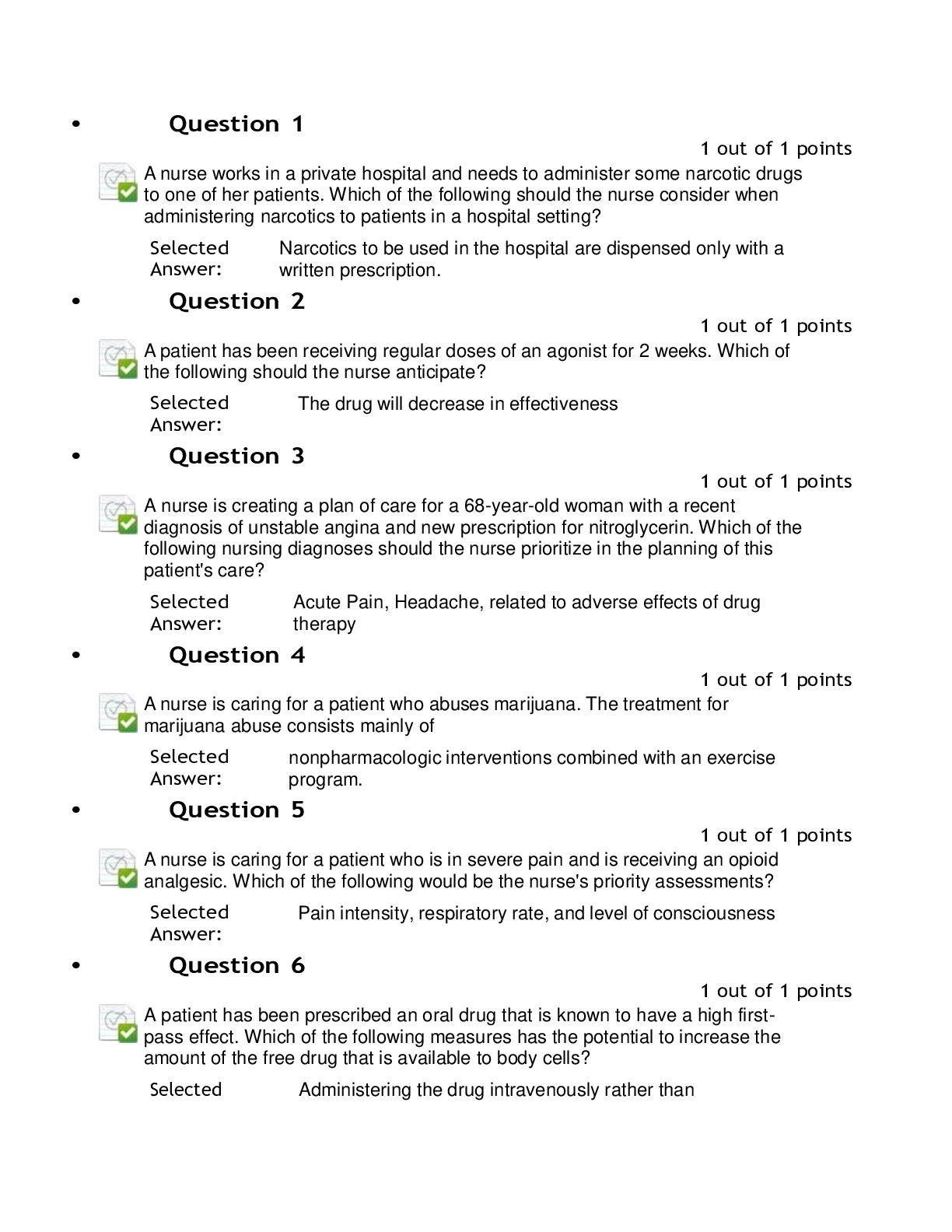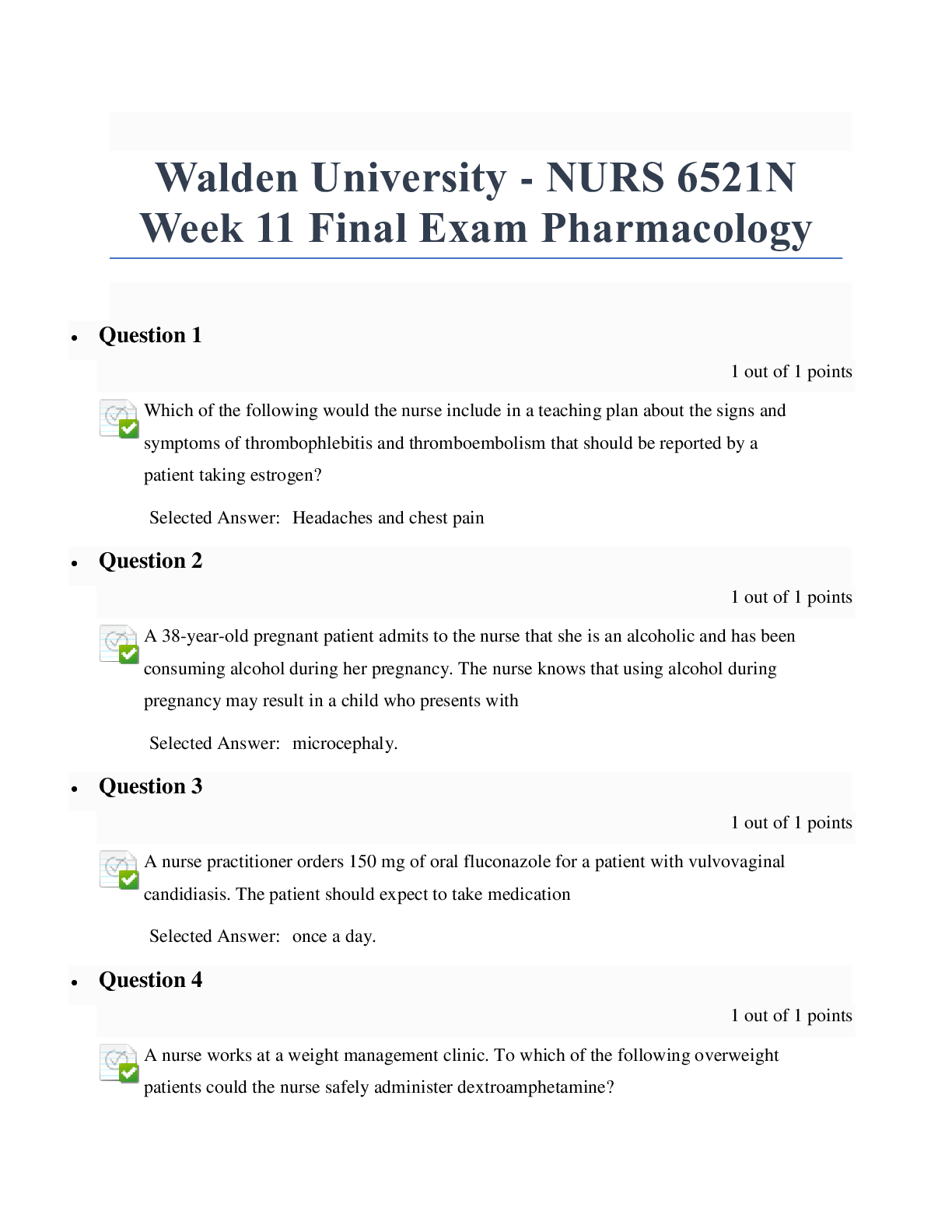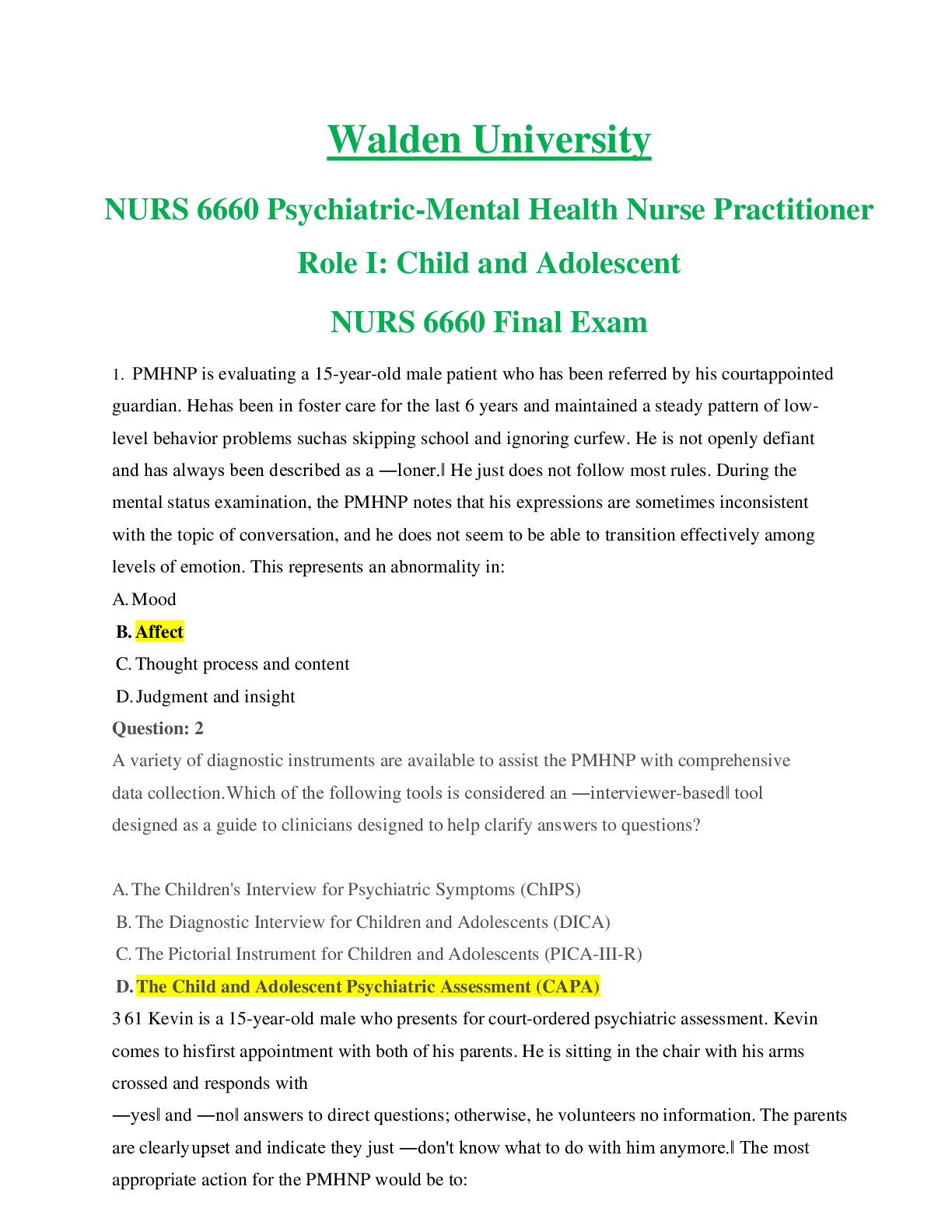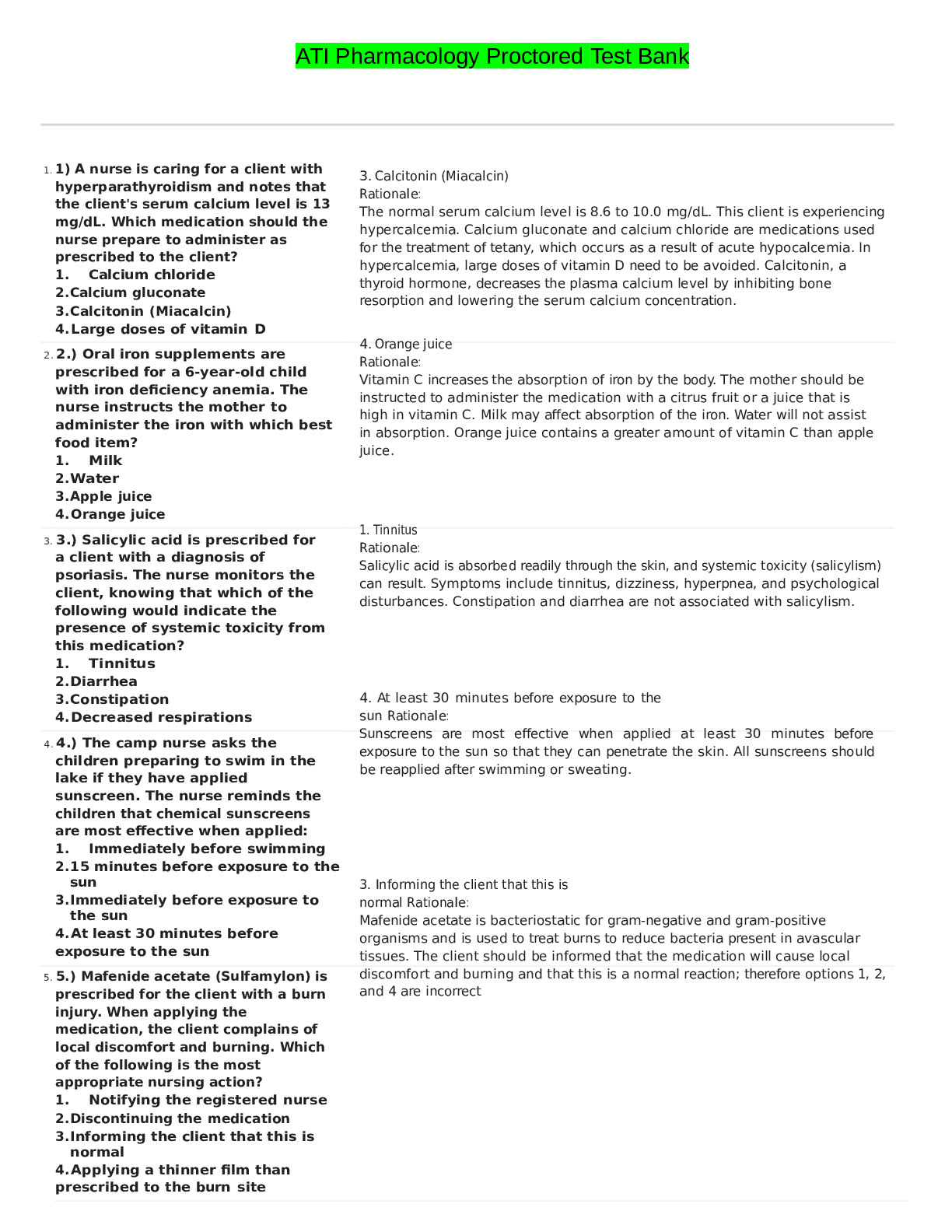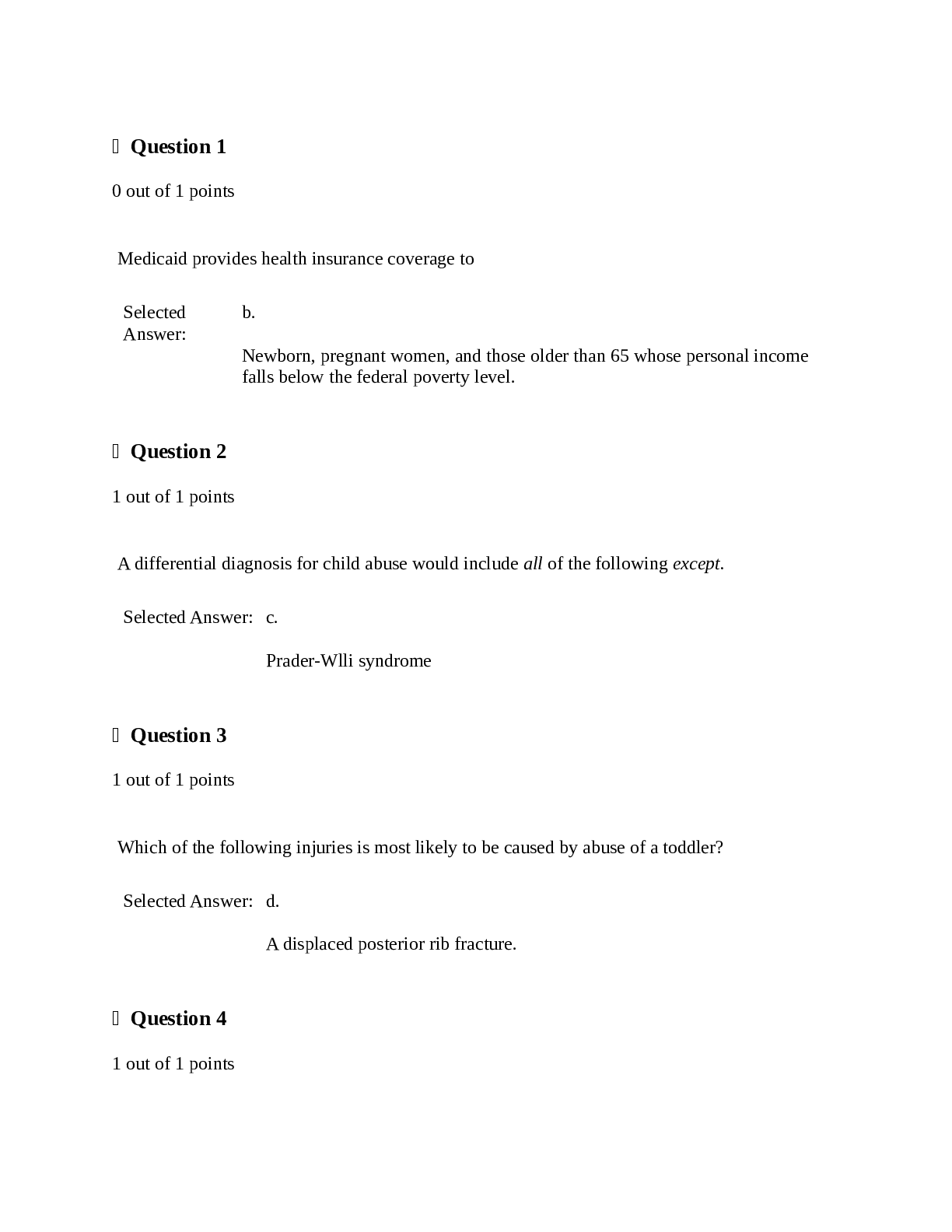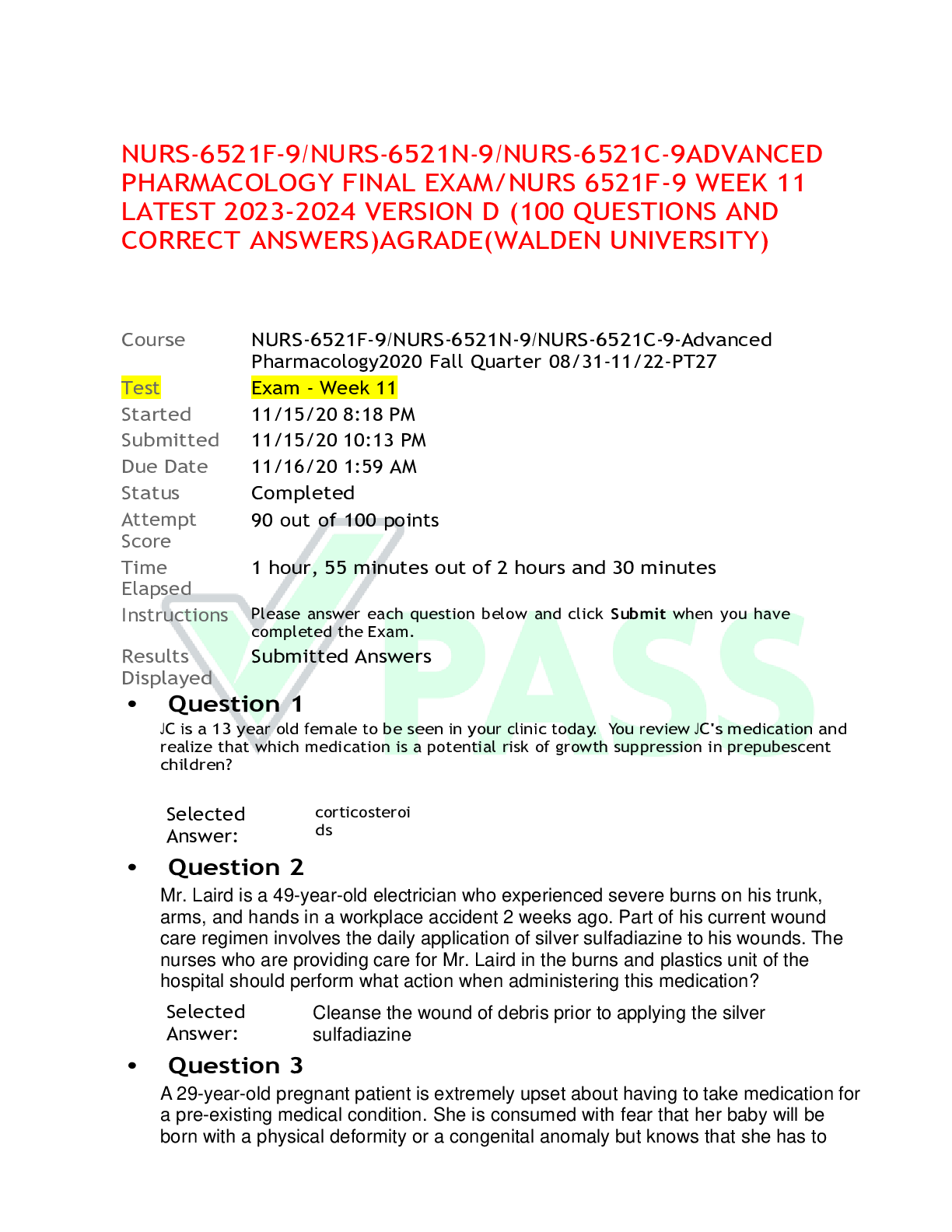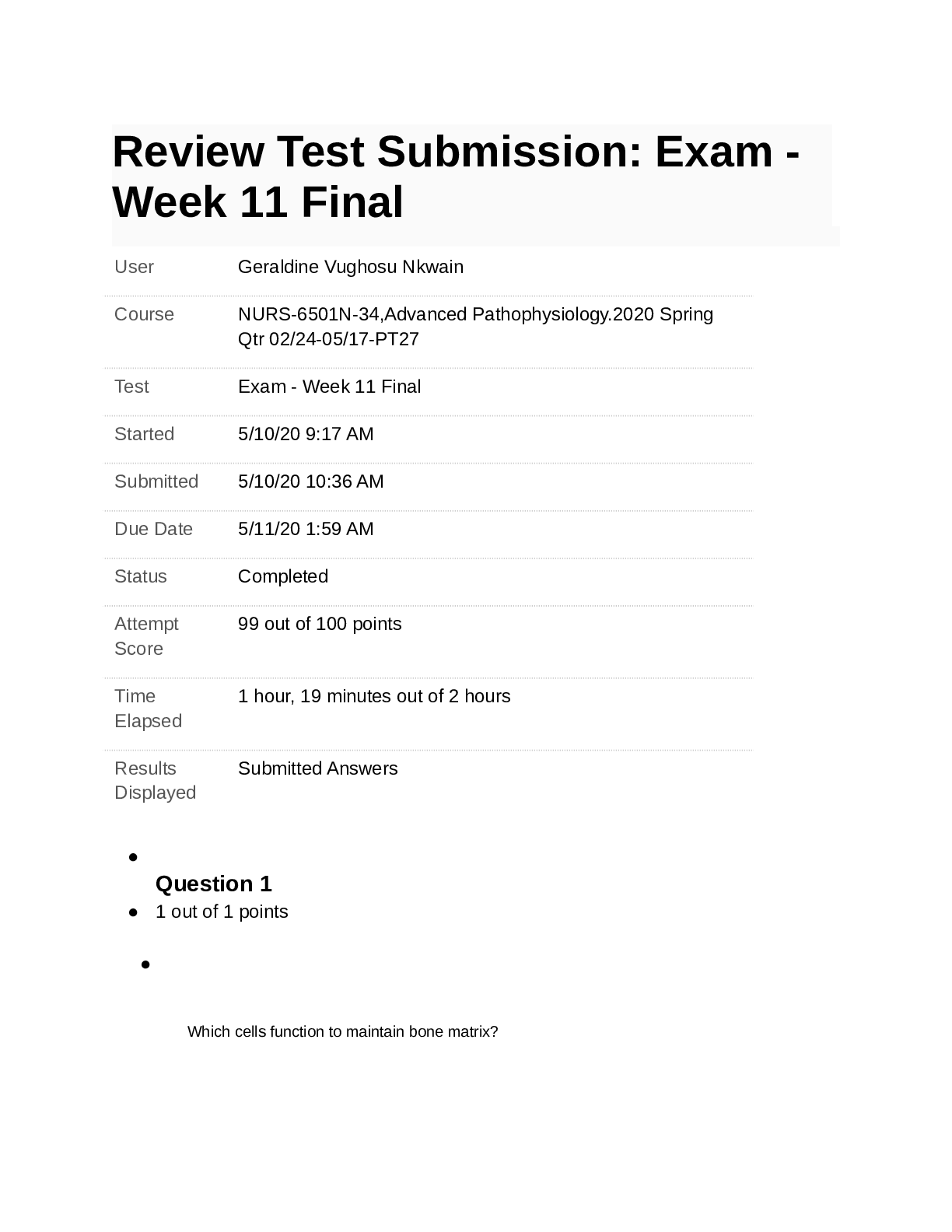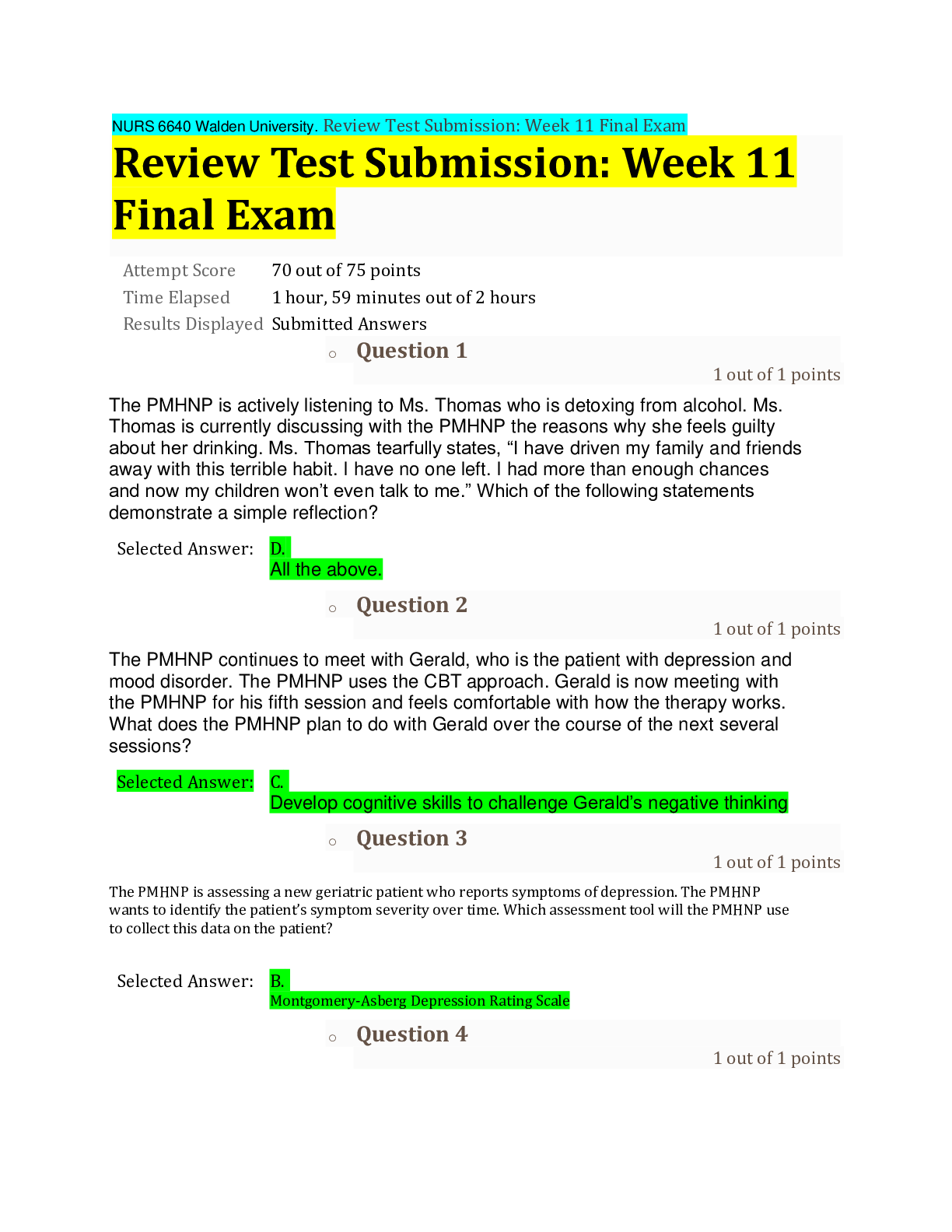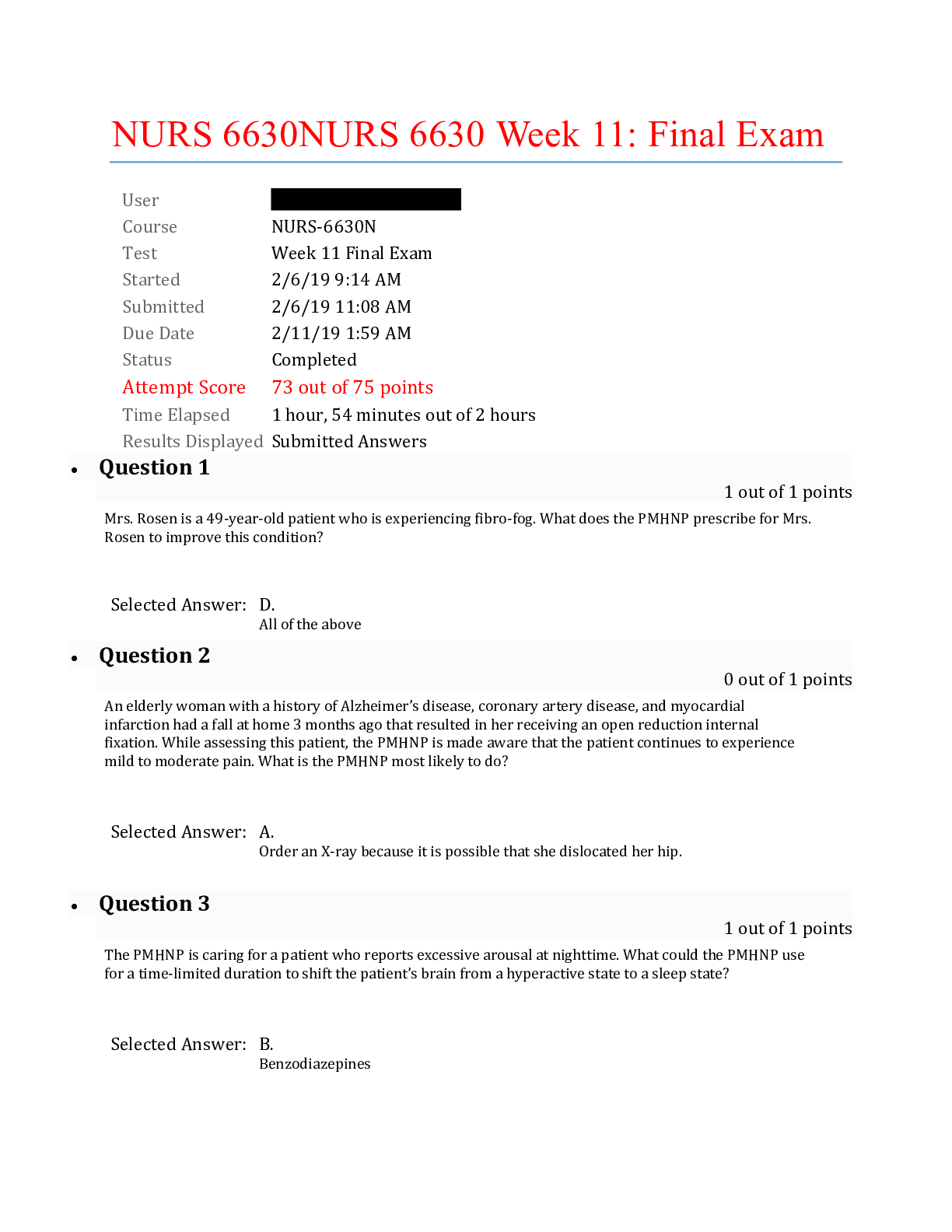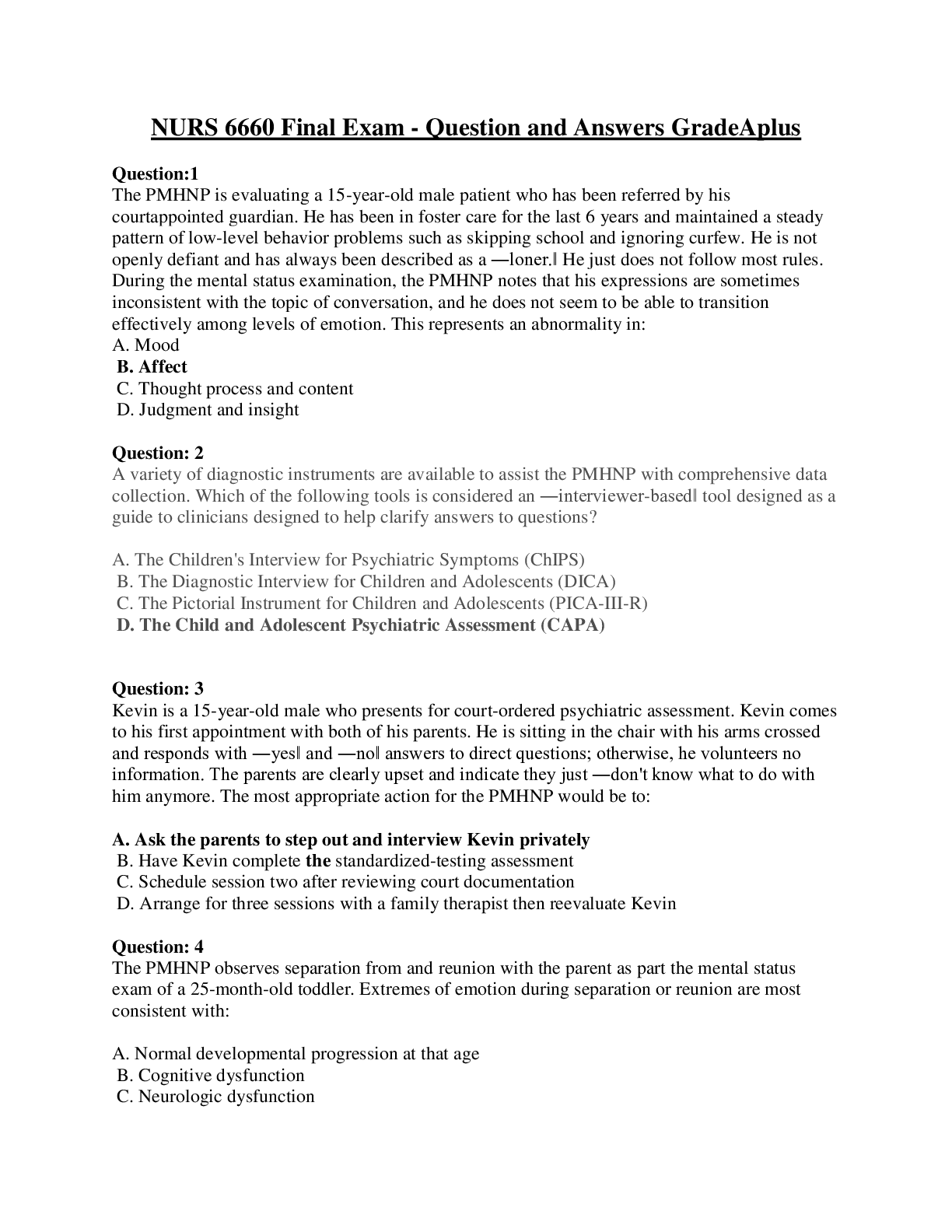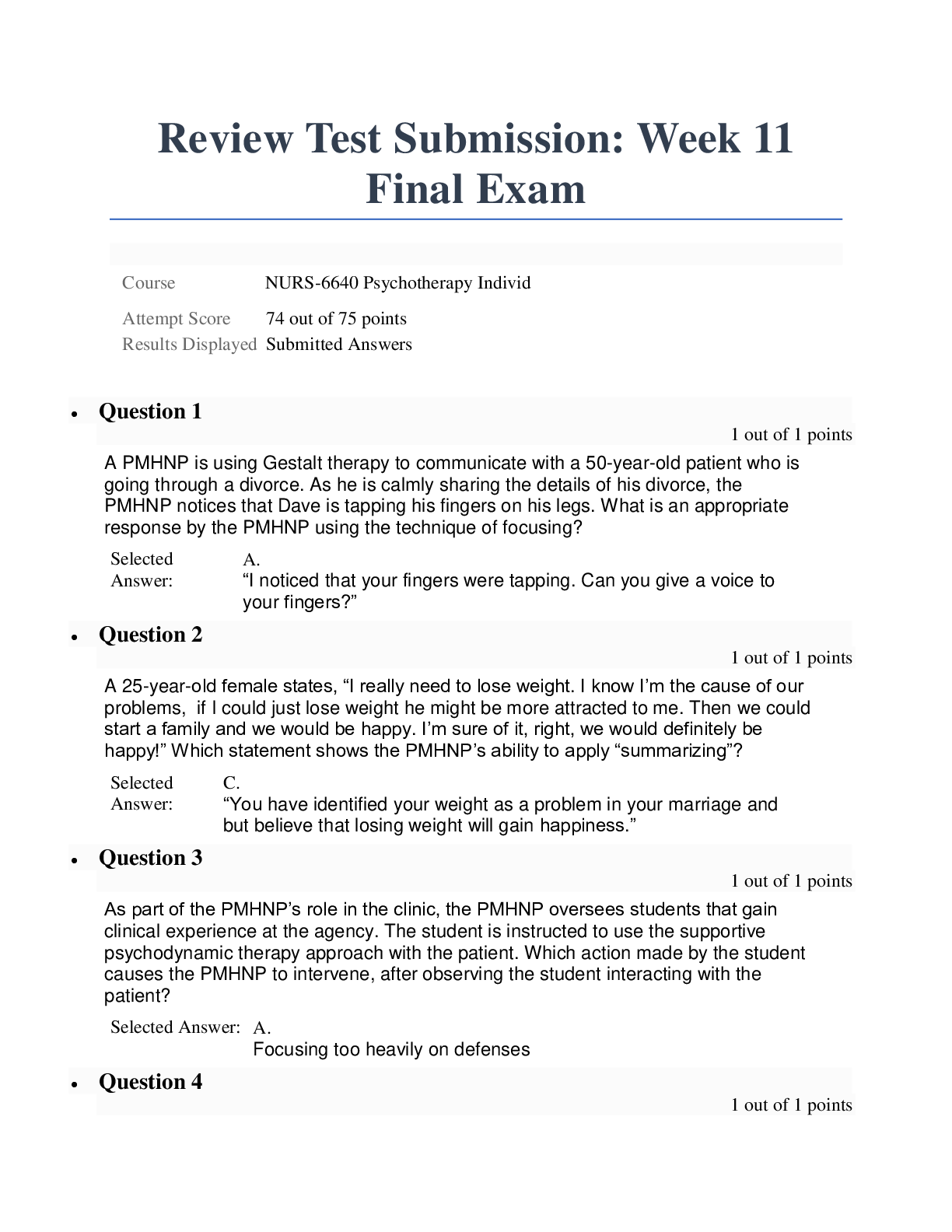*NURSING > EXAM > NRNP 6665-01 Psychiatric Mental Health Week 11 Final Exam (Nov 2021) 100 Questions and answers (All)
NRNP 6665-01 Psychiatric Mental Health Week 11 Final Exam (Nov 2021) 100 Questions and answers
Document Content and Description Below
1. Question: An illness of symptoms or deficits that affect voluntary motor or sensory functions, which suggest another medical condition but that is judged to be caused by psychological factors becau... se the illness is preceded by conflicts or other stressors in known as which of the following? 2. Question: A condition characterized by the person giving approximate answers, with clouding of consciousness, frequently accompanied by hallucinations or other dissociative, somatoform or conversion symptoms is 3. Question: Which of the following can cause delirium? Check all that apply. 4. Question: Acute withdrawal from alcohol represents which type of clinical problem in psychosomatic medicine? 5. Question: The principal theoretician to bring psyche and soma together was which of the following? 6. Question: Which of the following would not be included in the treatment plan for a patient with illness anxiety disorder? 7. Question: Which of the following is consistent with current literature about the relationship between obstetrical complications and Autism Spectrum Disorders (ASD)? 8. Question: The epidemiology related to kleptomania includes which of the following? 9. Question: A frontotemporal dementia with onset in the fifth to sixth decade of life, more common in men, marked by personality change and cognitive decline, is known as which of the following? 10. Question: Which of the following demographics are consistent with autism spectrum disorder (ASD) 11. Question: The ARNP is working with the family of a patient with Alzheimer’s Disease who keeps stating the family is plotting against her, trying to have her “snuffed out.” The family is distraught because they state they are doing their best to make sure their family member is safe. The ARNP explains which of the following in educating the patient about the patient’s 12. Question: Which of the following persons hypothesized that the symptoms of conversion disorder reflect unconscious conflict? 13. Question: Which of the following is consistent within normal range developmental milestones in adaptive skills for a 4-year-old? 14. Question: A temporary marked alteration in the state of consciousness or by the customary sense of personal identity without the replacement by an alternate sense of identity is known as which of the following? 15. Question: Differential diagnoses to be considered when diagnosing Ganser syndrome include which of the following? 16. Question: A patient who has been raped, presents with the inability to recall important personal information and any information about the rape, does recall events prior and since. There does not appear to be any physiological reason for this. This presentation is consistent with which of the following diagnoses? 17. Question: Depersonalization can result from which of the following conditions? Check all that apply. 18. Question: A child who demonstrates repetitive significant violations of social rules and the rights of others over the course of a year would likely be diagnosed with which of the following diagnoses? 19. Question: A sudden unexpected purposeful travel away from home with inability to recall all of one’s past accompanied by confusion about personal identity not due to direct effects of a substance or a general medical condition which causes clinically significant distress or impairment in social, occupational, or other important areas of functioning is most specifically known as which of the following? 20. Question: Which of the following is NOT considered a nonpathological form of amnesia? 21. Question: The diagnosis formerly known as multiple personality disorder is now known as which of the following? 22. Question: A patient presents reporting acute amnesia and fugue episodes in addition to recurrent blackouts, unexplained possessions, and fluctuations in skills, habits, and knowledge. The ARNP recognizes this is consistent with which of the following? 23. Question: Deficits in language including naming, repetition, reading and comprehension, and writing is NOT associated with impairment in which of the following regions of the brain? 24. Question: A major neurocognitive disorder with severe impairment in memory, judgment, orientation, and cognition is known as which of the following? 25. Question: The patient with an illness anxiety disorder is requesting medication only from the ARNP. The ARNPs response about pharmacotherapy in illness anxiety disorder would include which of the following? 26. Question: Which of the following is consistent with what is known about kleptomania? 27. Question: A type of delirium characterized by cycling through psychomotor agitation and retardation, from apathy to hypervigilance is known as which of the following? 28. Question: Under hypnosis or during psychotherapy, a patient may recover a memory of a painful experience that is etiologically significant. This is known as which of the following? 29. Question: Which of the following conversion disorder symptoms are associated with a good prognosis? 30. Question: According to the DSM-5 which of the following symptoms differentiates illness anxiety disorder from somatic symptom disorder? 31. Question: A recurrent failure to resist impulses to steal objects not needed for personal use or monetary value is an essential feature of which of the following disorders? 32. Question: Which of the following would be a cause of concern for the ARNP working with parents of a 0–3 month old? 33. Question: Identifying developmental milestones is an important skill set for ARNPs for which of the following reasons? 34. Question: Which of the following is true about compulsions? 35. Question: The ARNP recognizes which of the following when the 2-month-old opens her mouth when she sees a bottle. 36. Question: The ARNP notices the 6-month-old does not have a spontaneous smile response and realizes which of the following? 37. Question: Data supports which of the following demographics of persons with conversions disorder? 38. Question: Which of the following is consistent with what is known about electroconvulsive therapy (ECT) use in patients with Dissociative Identity Disorder (DID)? 39. Question: Which of the following conditions associated with childhood are part of the five conditions which comprise disruptive, impulse-control, and conduct disorders? 40. Question: A category of disorders characterized by the inability to resist an intense impulse, drive, or temptation to perform a particular act that is obviously harmful to self or others or both is known as which of the following? 41. Question: A person reveals to the ARNP that they steal to get the things they want and cannot afford. The person says they just can’t help themselves, because they have kleptomania. The ARNP realizes the following: 42. Question: Which of the following would demonstrate the normal achievement of gross motor developmental milestone for a 6-month-old? 43. Question: According to a psychodynamic perspective, depersonalization and derealization are understood as which of the following? 44. Question: Which of the following is consistent with brain-imaging findings related to Autism Spectrum Disorder (ASD)? 45. Question: Which of the following biological factors have been associated with kleptomania? Check all that apply. 46. Question: The symptom of giving approximate answers is known as which of the following? 47. Question: An acute onset, short-term confusion, with changes in cognition and level of awareness due to a physiological cause is known as which of the following? 48. Question: A dissociative disorder described as an identity disturbance due to prolonged and intense coercive persuasion is known as which of the following? 49. Question: The ARNP in working with a parent of a 6-month-old would offer which of the following in anticipatory guidance? 50. Question: Which of the following are behavioral red flags for a 6–12-year-old? 51. Question: Neuropsychiatric testing is defined as which of the following? 52. Question: The term psychosomatic literally refers to which of the following? 53. Question: Which of the following questions are recommended to assess sexual identity in a male adolescent? 54. Question: A tension state that can exist without an action is known as which of the following? 55. Question: Which of the following diagnostic instruments for Autism Spectrum Disorder is recommended for universal clinical practice? 56. Question: A new diagnosis in the DSM-5 characterized by persons preoccupied with being sick or developing a disease of some kind is known as which of the following? 57. Question: Adisordercharacterizedby6ormoremonthsofgeneralandnodelusionalpreoccupations with fears of having a serious disease based on a person’s misinterpretation of bodily symptoms that causes significant distress and impairment in one’s lifeis 58. Question: Adisordercharacterizedby6ormoremonthsofgeneralandnodelusionalpreoccupations with fears of having a serious disease based on a person’s misinterpretation of bodily symptoms that causes significant distress and impairment in one’s life is 59. Question: A precipitous onset prion disease, with rapid decline, progressing to death within 6 months of onset is known as which of the following? 60. Question: A term use to describe a neuro developmental disorder characterized by impairments in reciprocal social communication and a tendency to engage in repetitive stereotyped patterns of behaviors, interests and activities is 61. Question: Which of the following is an example of a medical complication of psychiatric conditions or treatment? 62. Question: Experiences of depersonalization and derealization are common in which of the following patients? 63. Question: Which of the following shows normal developmental visual motor skill for an 18-month-old? 64. Question: Deficits in attention and the ability to complete multi-step commands are associated with impairment in which of the following regions of the brain? 65. Question: Which of the following is not consistent with what is known about depersonalization and derealization? 66. Question: The second-most common type of dementia caused by cardiovascular and cerebrovascular disease with progressive cognitive decline in stepwise fashion is known as which of the following? 67. Question: Which of the following would be a developmental red flag that would trigger further assessment for a 2-year-old? 68. Question: Which of the following are included in the clinical features of anxiety illness disorder? Check all that apply. 69. Question: A dementia which usually occurs in the sixth decade of life, characterized by gradual onset and progressive decline without focal neurological deficits is known as which of the following? 70. Question: Which of the following is true about impulses? Check all that apply. 71. Question: Which of the following is consistent with dementia in HIV? 72. Question: Somatoform disorders represent which type of clinical problem in psychosomatic Medicine? 73. Question: A type of delirium characterized by psychomotor retardation and apathy is known as which of the following? 74. Question: A child 0–3 months would be expected to be able to do which of the following? 75. Question: The ARNP is meeting with a person who reports a fascination with fire, along with recurrent deliberate and purposeful setting of fires. The ARNP realizes that these behaviors are consistent with which of the following disorders? 76. Question: Which of the following supports a good prognosis for a person with a conversion disorder? 77. Question: Which of the following medications are FDA-approved medications for the treatment of delirium? 78. Question: Depression secondary to interferon treatments represents which of the following clinical problems in psychosomatic medicine? 79. Question: Which of the following is a common visceral symptom of conversion disorder? 80. Question: Which of the following are common disorders that must be differentiated from dissociative identity disorder? Check all that apply. 81. Question: In treating a patient with dementia and a co-occurring depression, which of the following symptoms should be treated first? 82. Question: Which of the following is consistent with normal range gross motor developmental milestones for a 4 year old? 83. Question: Which of the following social interactions indicates progression into the normal range, meeting developmental milestones for a 5-year-old? 84. Question: Visual hallucinations are associated with impairment in which of the following regions of the brain? 85. Question: The ARNP is doing a physical exam on a patient that has a paralyzed hand of unknown etiology in which the patient’s hand is raised and dropped into the patient’s face. Which of the following patient responses support the finding of a conversion disorder? 86. Question: Which of the following are included in the five different milestone skill areas that should be evaluated? 87. Question: Which of the following approaches/treatments are recommended in working with patients with a conversion disorder? 88. Question: Which of the following adaptive skills are consist with normal range developmental milestone of an 18-month-old? 89. Question: N-Methyl D-aspartate glutamate receptor antagonists are used to treat dementia by doing which of the following? 90. Question: Which of the following is NOT consistent with what is known about intermittent explosive disorder across the lifespan? 91. Question: Which of the following is not consistent with what is known about the epidemiology of dissociative fugue? 92. Question: A cognitive assessment should include which of the following? 93. Question: The ARNP notices that a patient with a conversion disorder unable to walk has an inappropriately cavalier attitude toward what seems to be a major impairment and recognizes this an associated psychological symptom known as which of the following? 94. Question: Which of the following speech and language skills are consistent with normal developmental milestones of a 3-year-old? 95. Question: A patient presents with persistent feelings of detachment from one’s self, like watching one’s self in a movie. The ARNP recognizes this as which of the following? 96. Question: Schizophrenia in a patient with end-stage renal disease is an example of which type of clinical problem in psychosomatic medicine? 97. Question: A person erroneously believes they sustained an emotional or physical trauma in early life is known as which of the following? 98. Question: MRI findings in patients with intermittent explosive disorder may reveal changes to which area of the brain that is associated with loss of impulse control? 99. Question: The ARNP evaluates a 4-year-old who cannot balance on one foot for 3 seconds, cannot copy a circle and realizes which of the following? 100. Question: Which of the following is consistent with what is known about treating individuals with kleptomania? [Show More]
Last updated: 1 year ago
Preview 1 out of 30 pages

Reviews( 0 )
Document information
Connected school, study & course
About the document
Uploaded On
Oct 12, 2022
Number of pages
30
Written in
Additional information
This document has been written for:
Uploaded
Oct 12, 2022
Downloads
0
Views
29


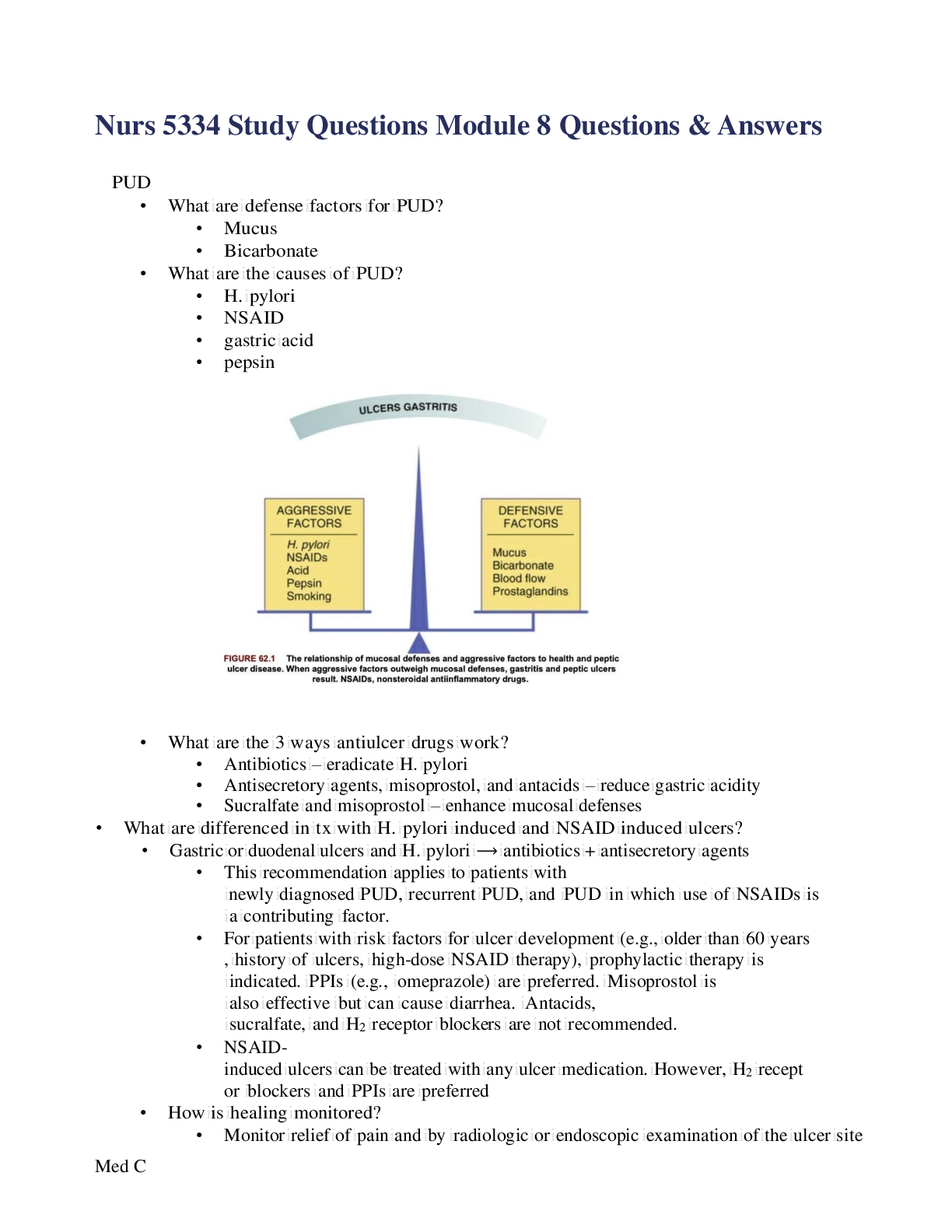
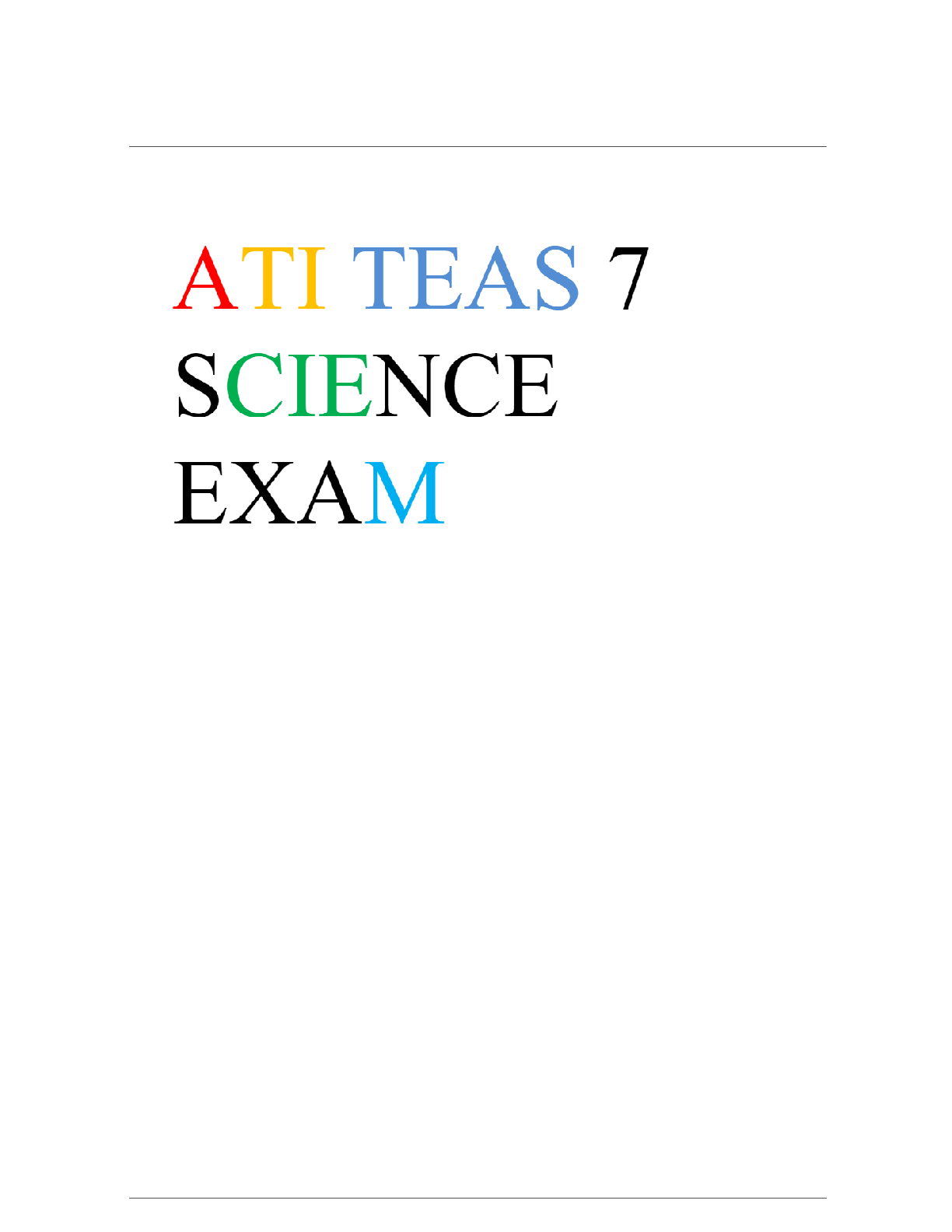
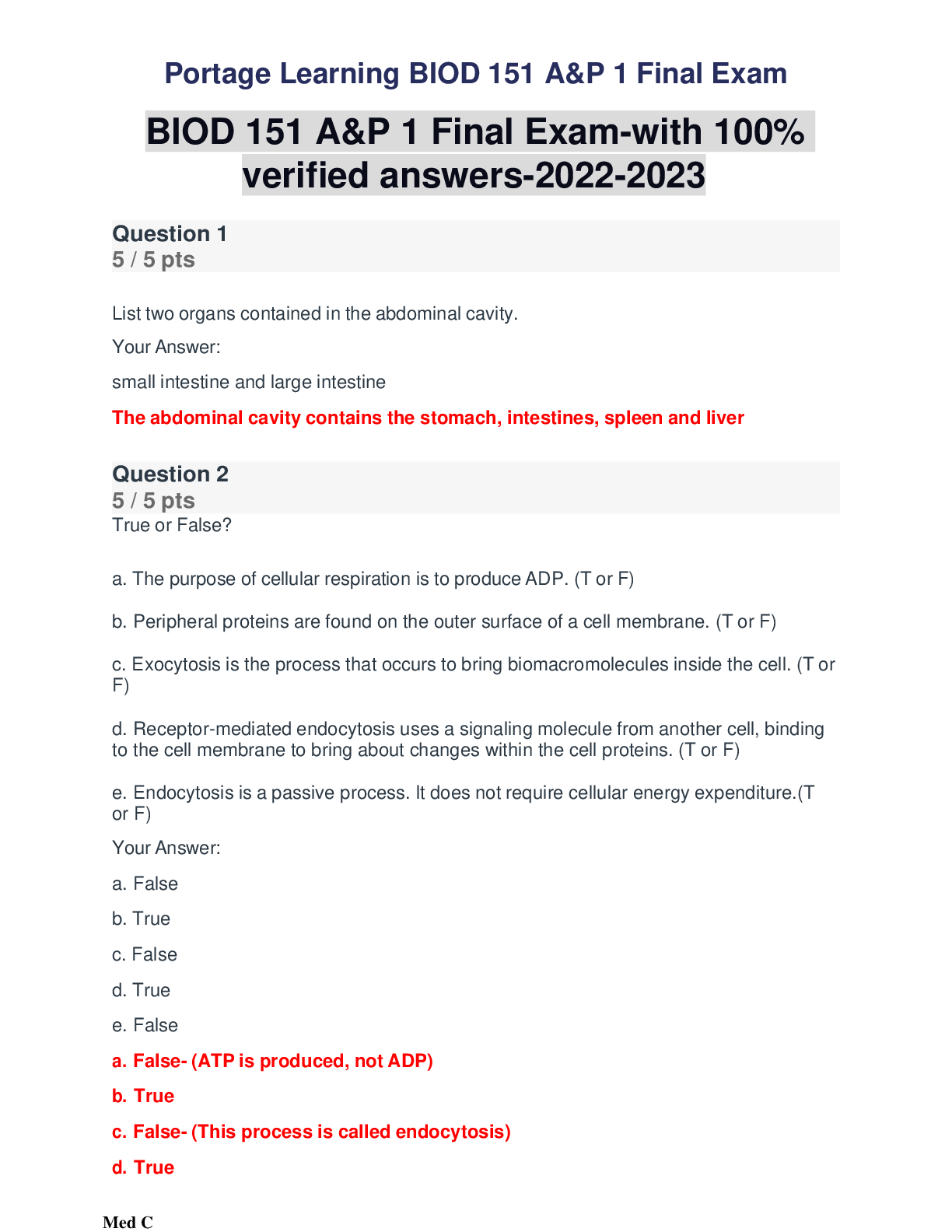
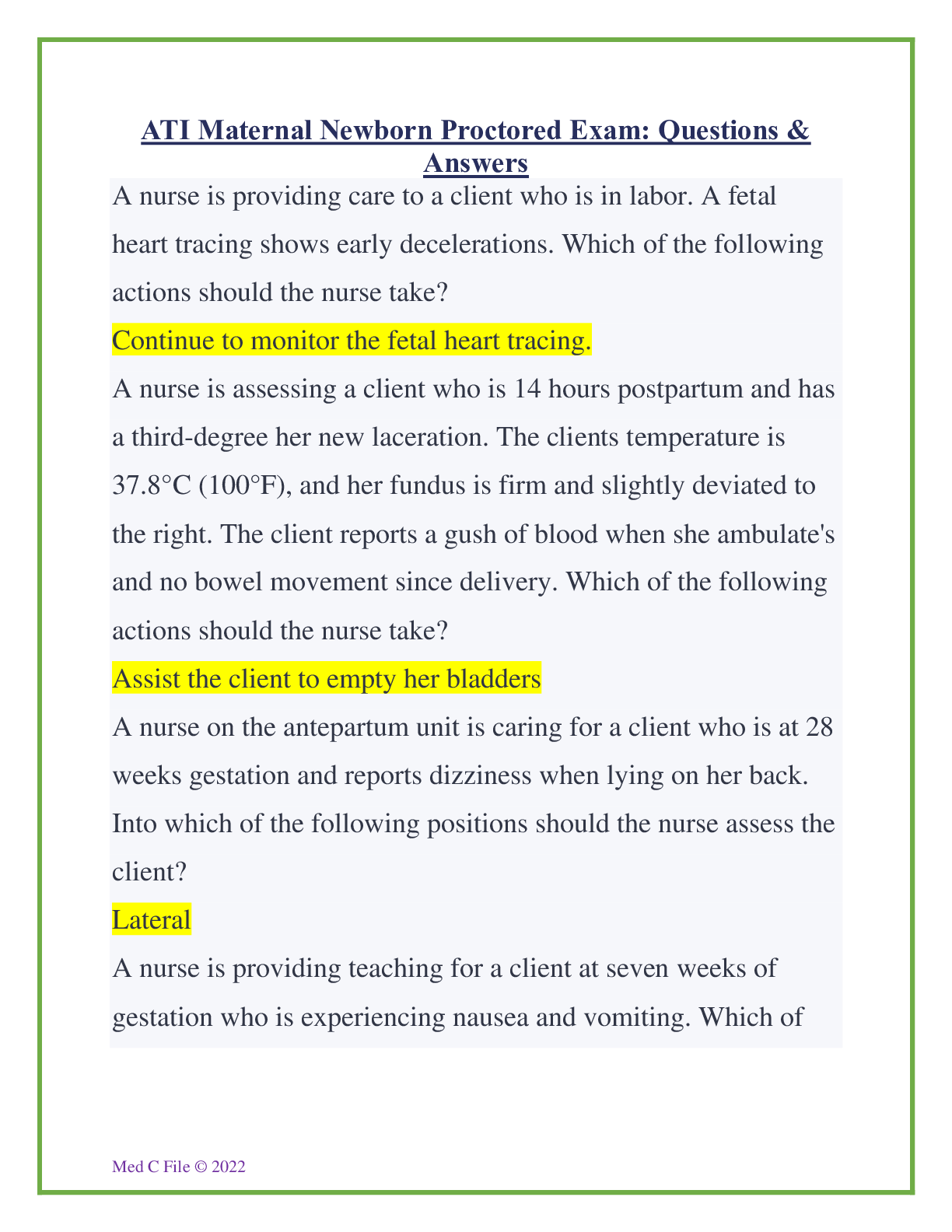



.png)

